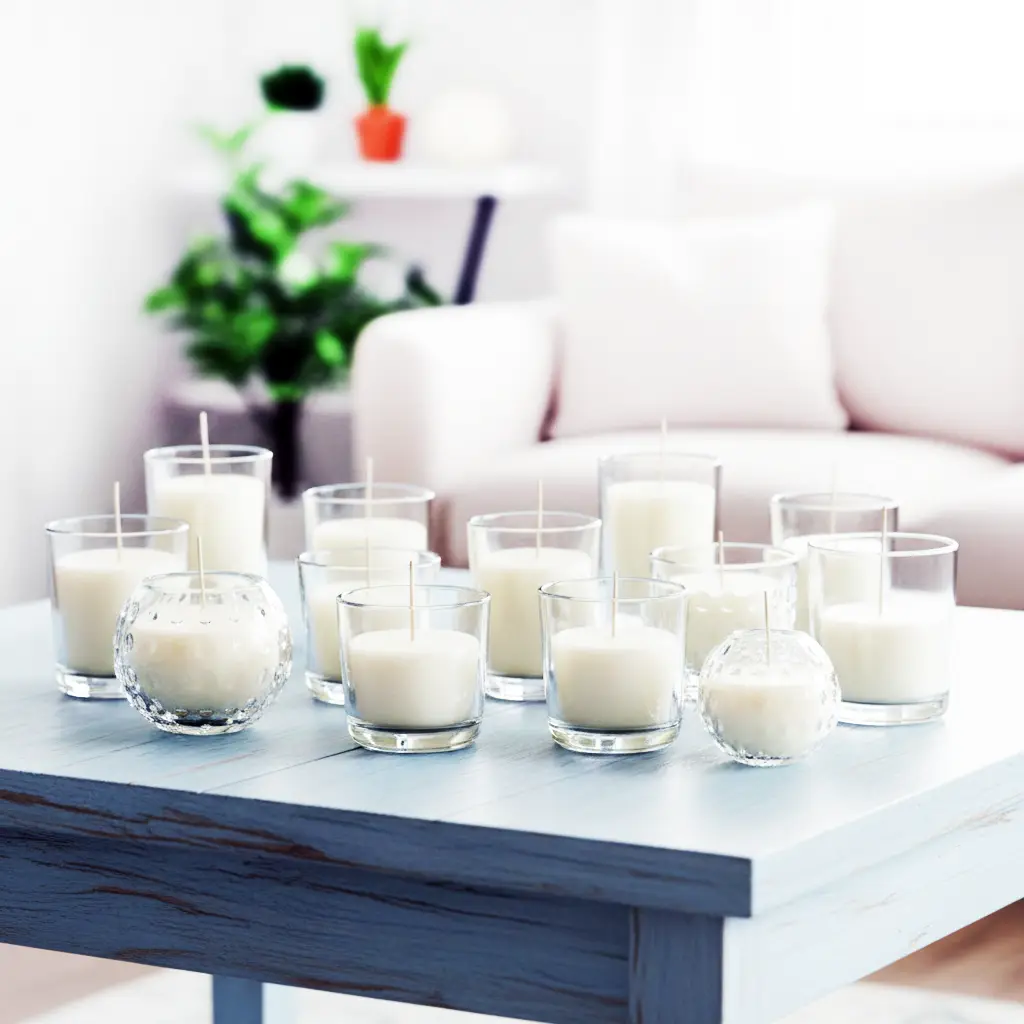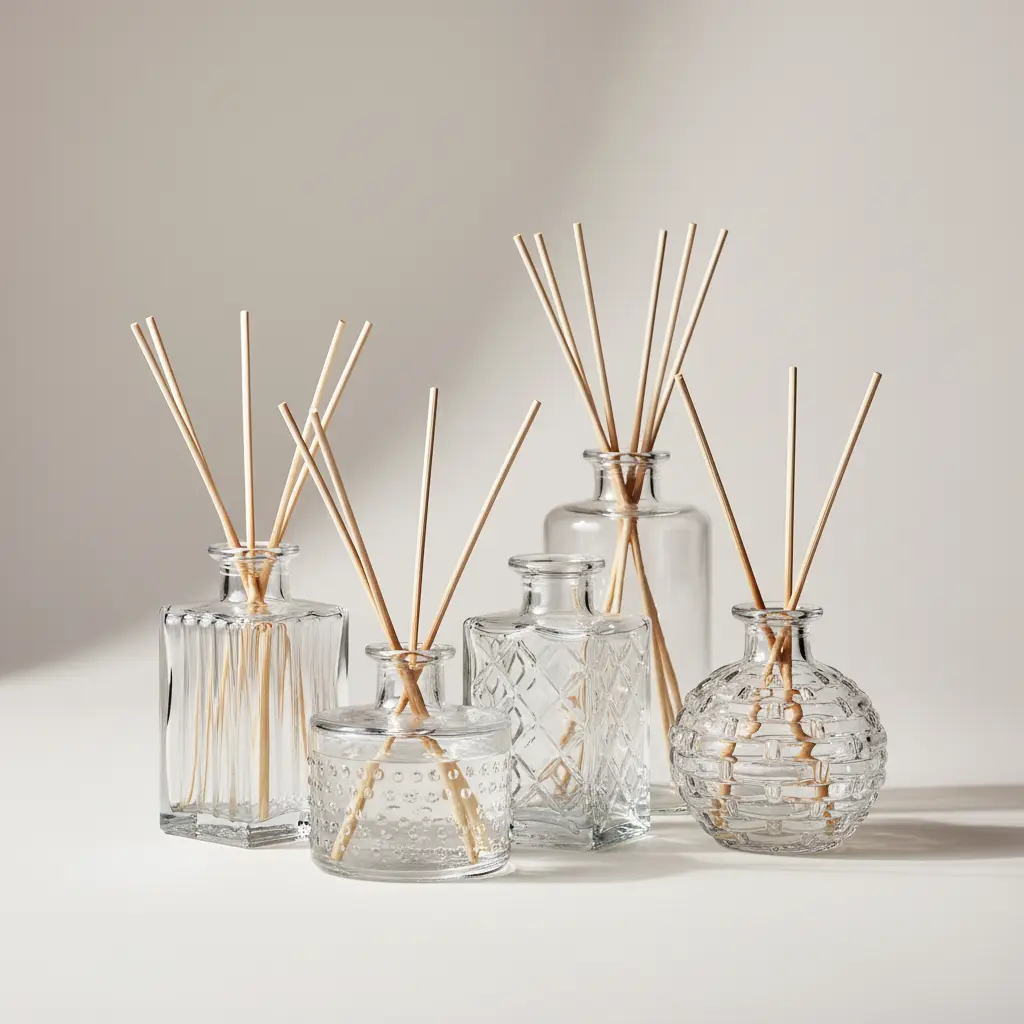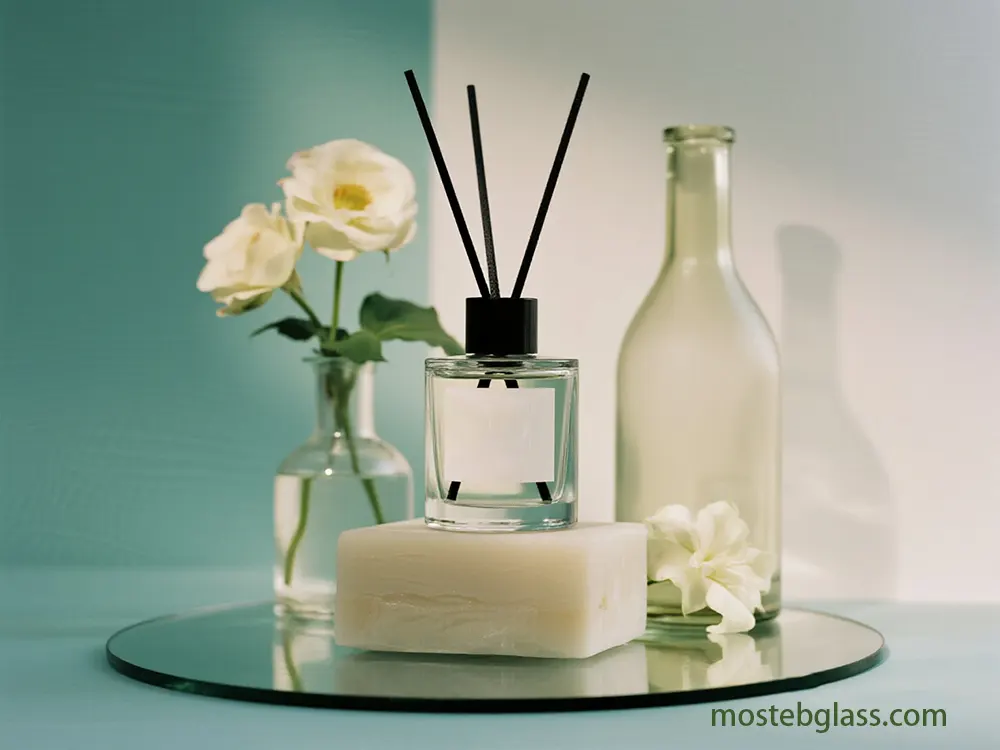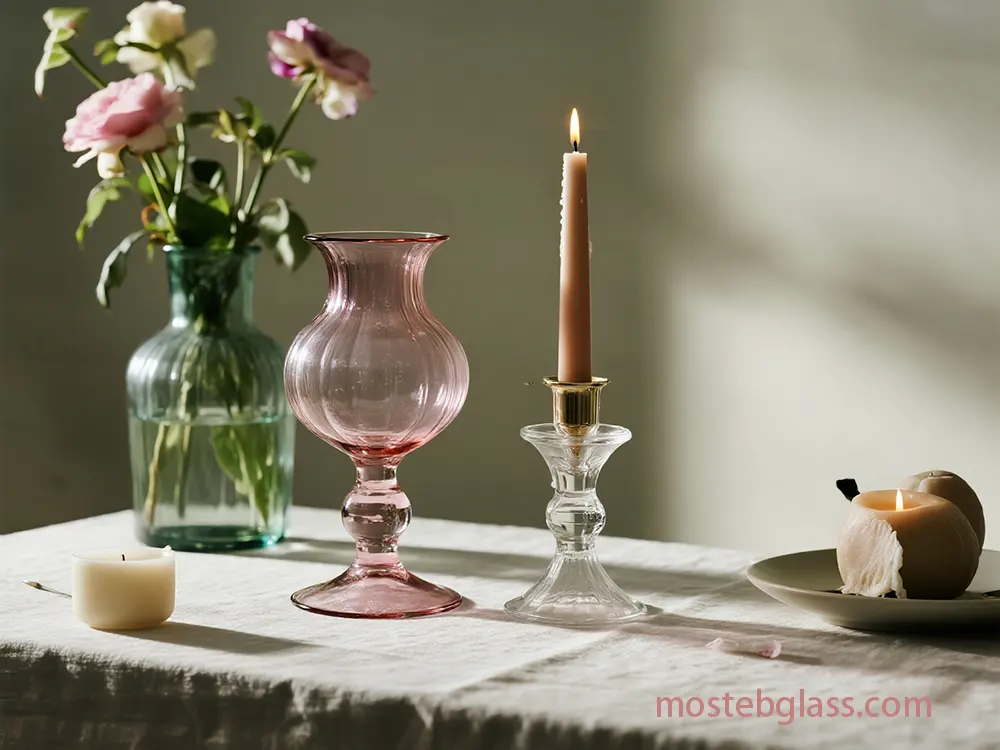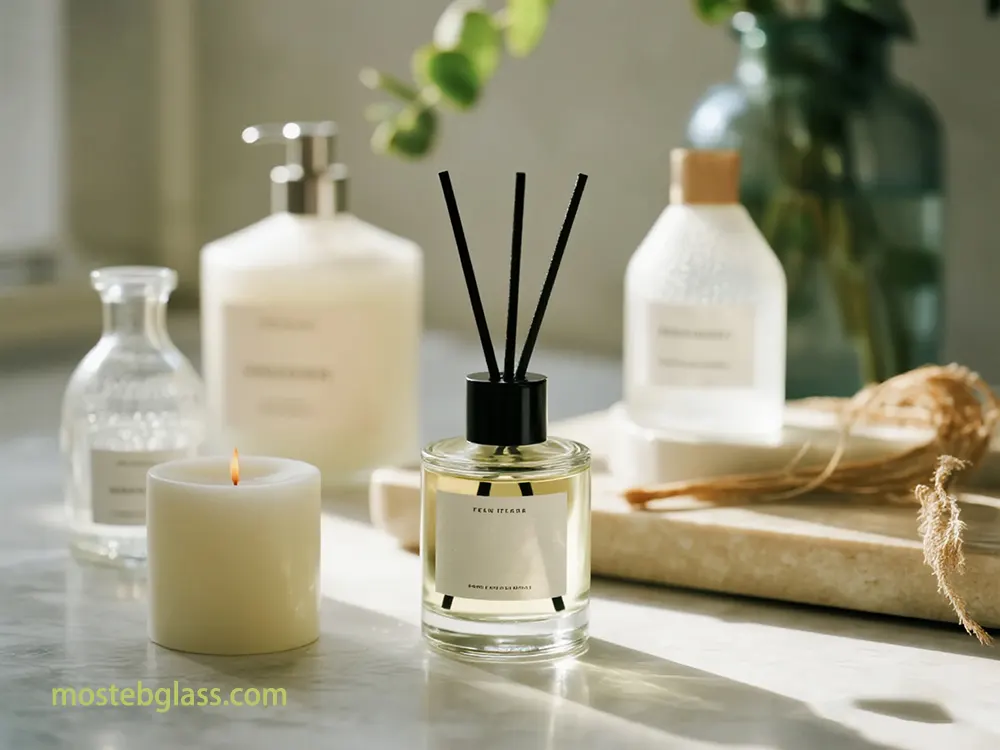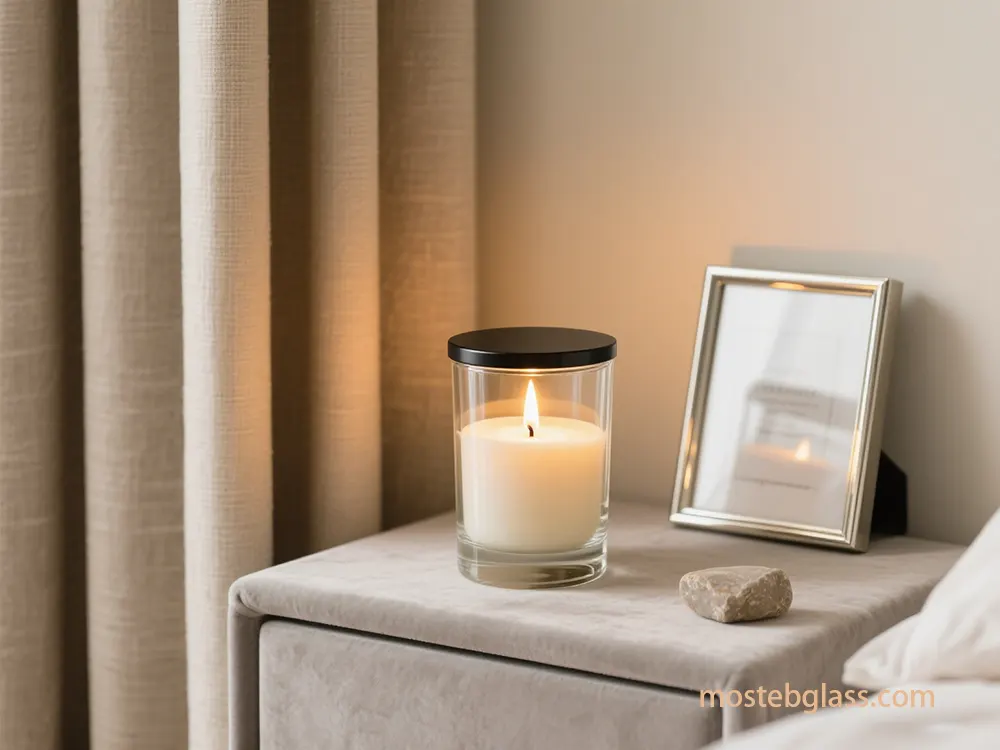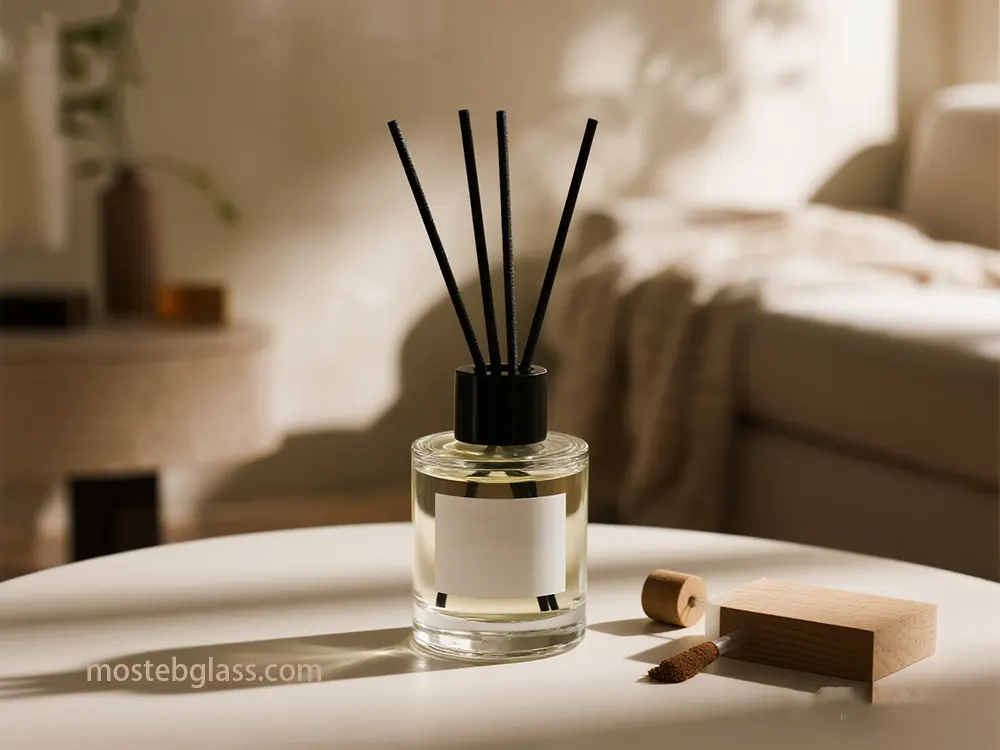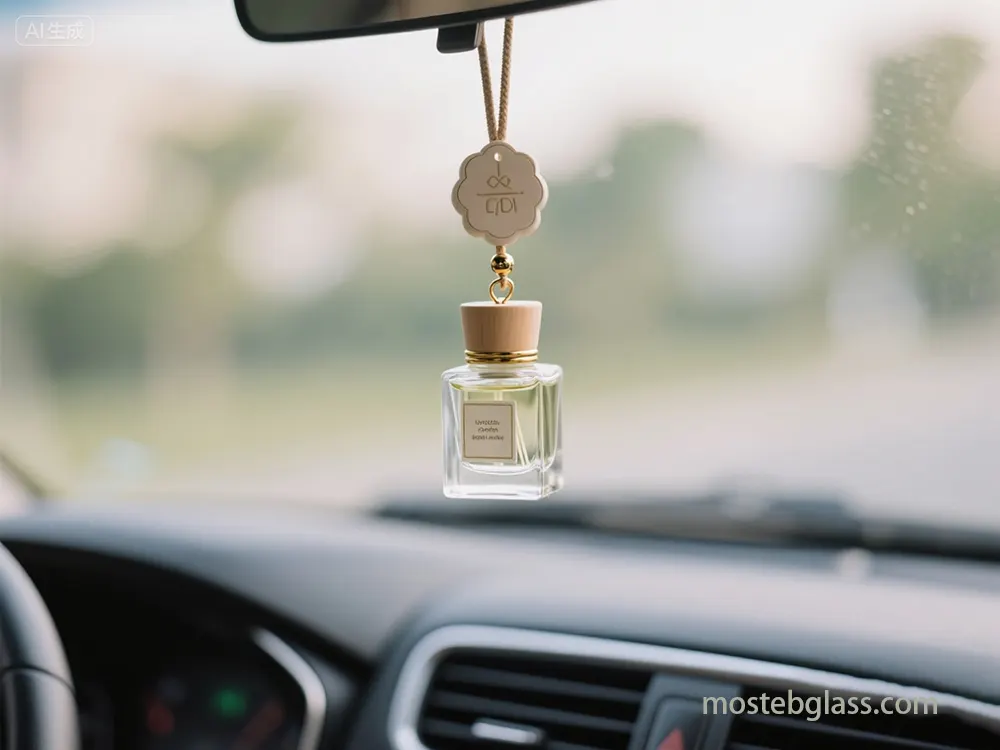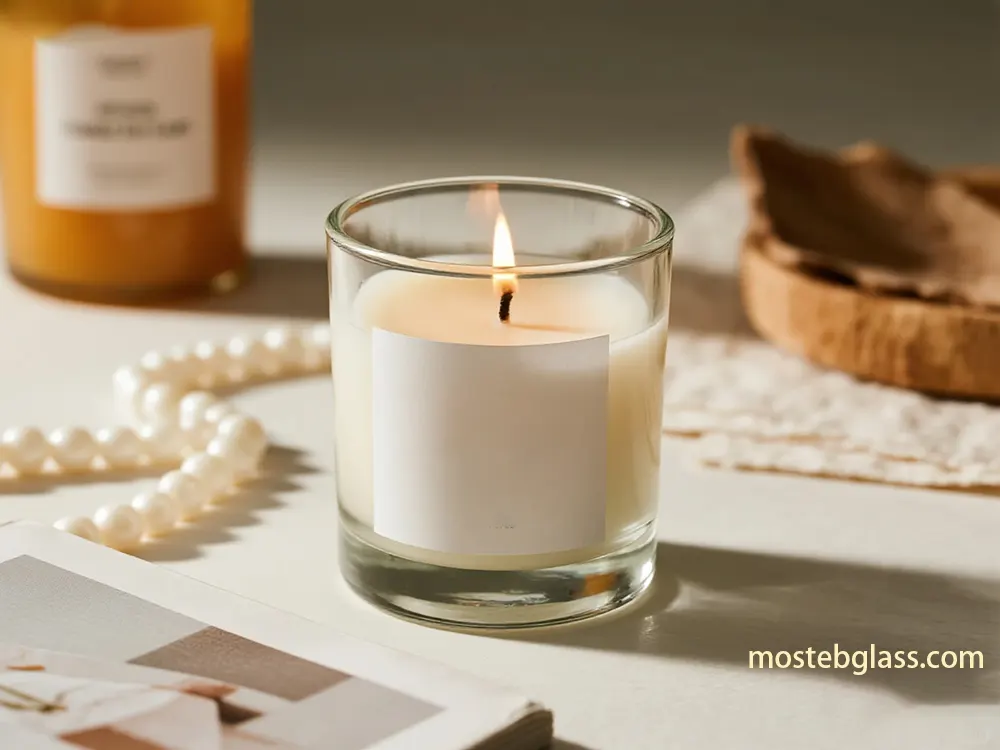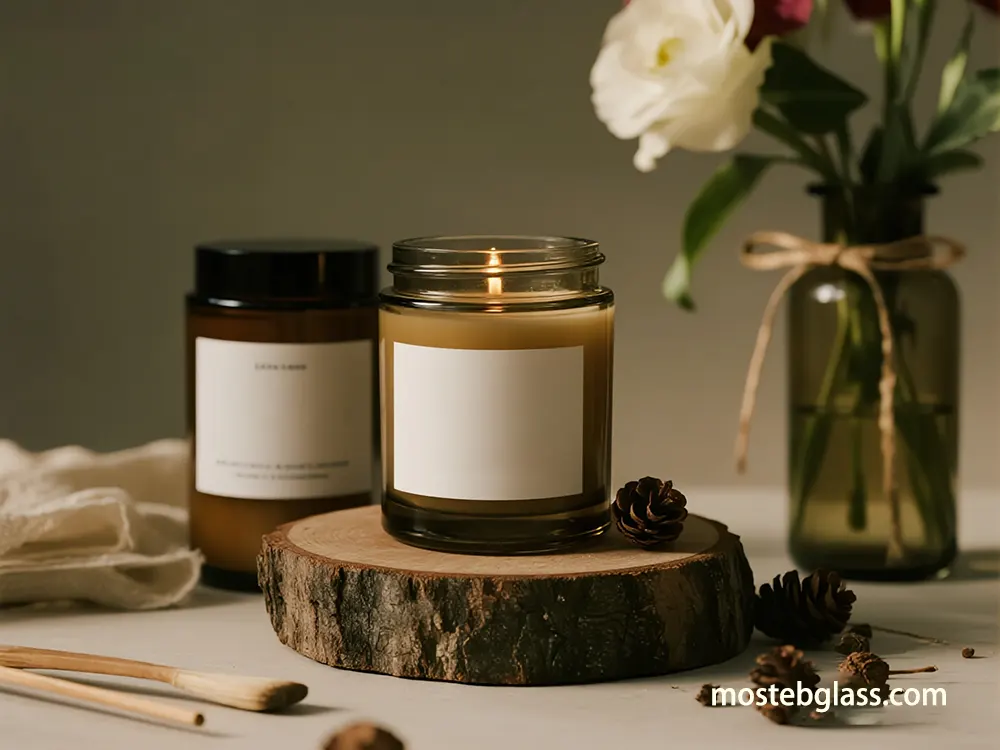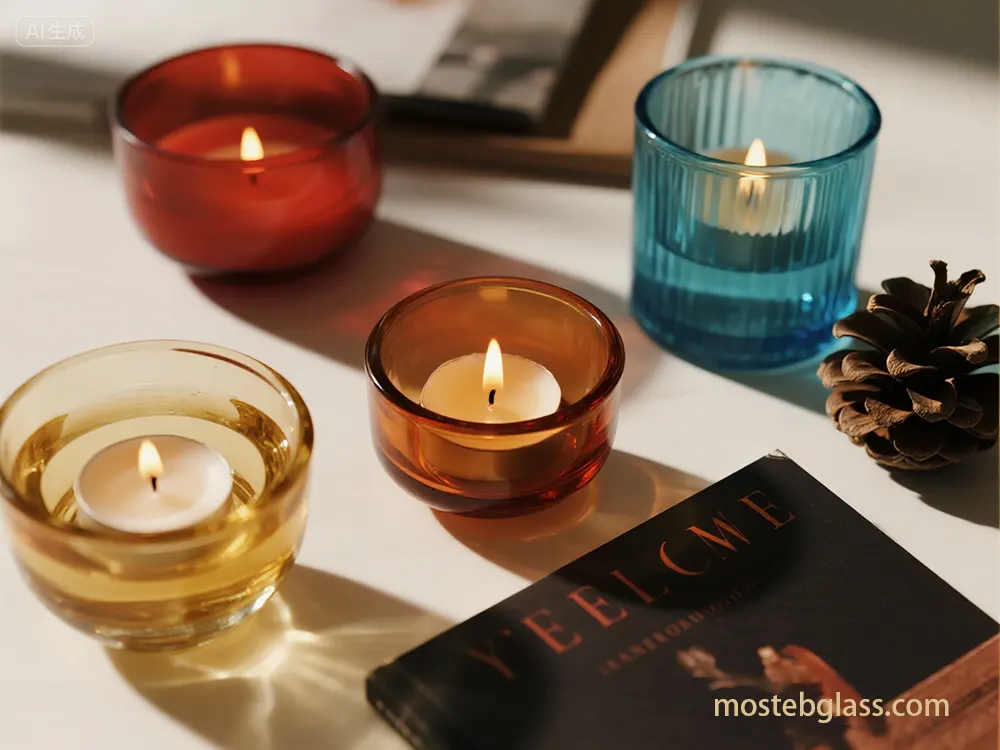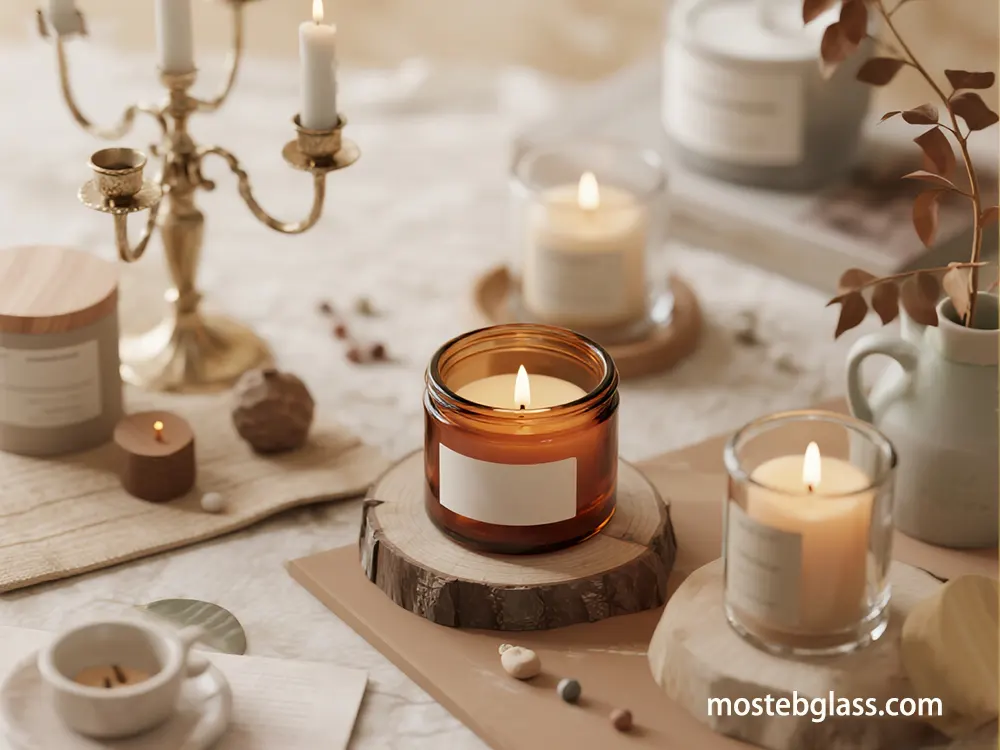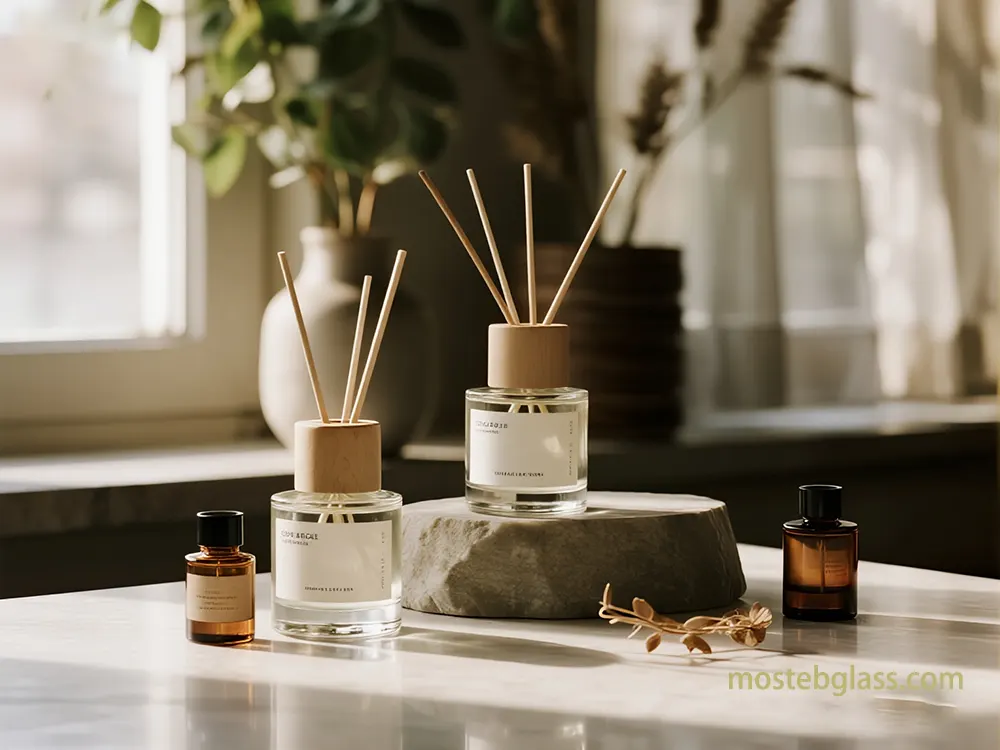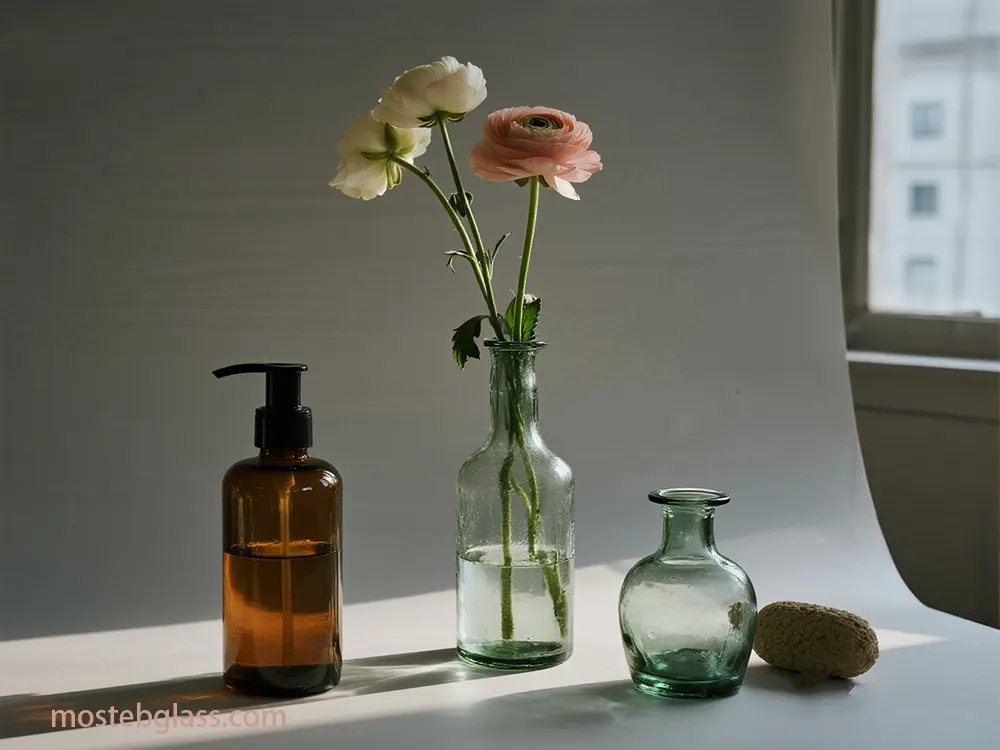What consumers want the world over for candle containers is quality, visually attractive, and environmentally friendly products. The demand for these articles is escalating rapidly as a result of changing consumer preferences, and consumers’ increased awareness of the environment. Being a major 유리 양초 병 factory, Mosteb is taking the best advantage of these changes through modern production, dazzling design, and a strong, transparent value chain.
1. Precision Manufacturing & Technology at a Leading Glass Candle Jars Factory
Here, we describe the precise manufacturing methods, material science innovations, and technology advancements that are changing raw glass into high-quality, uniform candle jars.
1.1. Advanced Molding Processes for Superior Dimensional Accuracy and Structural Integrity
모스테브 employs the most up-to-date glass container manufacturing methods to assure utmost dimensional accuracy and structural integrity of its candle jars. The Narrow-Neck Press-and-Blow (NNPB) method is very efficient in obtaining the exact glass distribution control because it can reduce the glass weight by as much as 33% without the glass losing its mechanical strength. This is very important for the production of light but strong containers having uniform wall thickness since this results in edges and seams becoming more secure thus, deserve the precision consistency and efficiency in packaging which are areas where there is a high demand. In the case of wide-neck jars, cups, and containers that need the wall to be evenly distributed, the Press-and-Blow (P&B) method is the one used.Both NNPB and P&B methods comprise the initial formation of molten glass by a plunger in a blank mold to obtain a parison, after which the parison is transferred to a blow mold for the final shaping with compressed air.The efficiency of these operations is further improved by servo-controlled units, real-time observing, and digital control interfaces which are some of the features that the facilities use for carrying out these operations.
1.2. State-of-the-Art Machinery and Equipment Models in Modern Glass Candle Jars Factory Production
Mosteb’s production lines are equipped with the most modern machinery that is sourced from the best suppliers in the world. Bucher Emhart Glass is the promoter and developer of the latest technologies for both the manufacturing and the inspection processes of this industry, and they also offer their IS (Individual Section) machines that are designed to support Blow & Blow (B&B), Press & Blow (P&B), and NNPB processes. The most noteworthy features of these machines are the FlexIS3 control system, Servo Electric Gob Distributor, VertiFlow blank and blow mold cooling, and Plunger Process Control (PPC) for closed-loop control.The AIS machine is distinguished from the others in terms of performance, production capacity, and maintenance-friendliness, and it features parallel Mold Open and Close (MOC) mechanisms, high-efficiency VertiFlow cooling, and individual cavity control for cooling. Upgrades like PPC2 bring even more process monitoring, quality control, and precise gob weight management capabilities.
Heye International, the pioneer of the NNPB process, is the supplier of the high-productivity HiePERFORM IS-Machines that are known for their high speed of production, long service life, and compact and clean design.Heye provides full closed-loop solutions for gob form and weight, blank side cooling, and press duration/glass distribution.Their Swabbing Robot mechanizes mold lubrication, thus ensuring accuracy, it uses infrared for the temperature measurement, and “swabbing on-the-fly” which can result in zero rejects from swabbing and up to 75% savings in lubrication.The Heye Rotor Mechanism is the benchmark for NNPB productions, therefore, it guarantees excellent thermal homogeneity and weight constancy in the glass mass.
1.3. Impact of AI/ML-Driven Process Control on Reducing Variability
The use of Artificial Intelligence and Machine Learning is very important to the optimization of Mosteb’s glass manufacturing processes to contribute greatly to the lowering of energy consumption and quality control improvement.
- Defect Detection and Reduction:AI-empowered systems particularly Deep Learning models are capable of performing on-the-spot product examinations, thus, they locate and identify defects such as scratches, inclusions, and bubbles with very high precision, in this way they reduce errors caused by humans and product wastes. This has resulted in the reduction of product defects by 3% due to better temperature control and a 4% decrease in defect rates because forming parameters in IS machines are adjusted dynamically.
- Process Optimization: AI is capable of managing huge amounts of data in real-time, this way it can find the best way for the process of forming, thus it leads to increased production efficiency, reduced cycle time and, raised throughput. At the same time, it reduces material waste by 3% through the prediction of raw material quality and the optimization of mixing.
- 예측 유지 관리: AI algorithms performing an analysis on data obtained from sensors and equipment can identify potential maintenance issues and thus suggest the scheduling of maintenance activities ahead of time which would result in a reduction of downtimes and an increase of the production efficiency.
- Variability Reduction and Cost Savings: Causal AI is capable of comprehending the interaction of process parameters it even allows for defects (e.g., bubbles, thickness variations) to be detected at an earlier stage and real-time countermeasures to be suggested. This technique can bring down the time for the diagnosis of quality problems from 4-6 weeks to only one day thereby giving room for a possible saving of up to $1 million per production cell yearly just by the reduction of ‘B’ grade products.
1.4. Novel Mold Materials and Coatings for Extended Mold Life and Improved Surface Quality
Mosteb uses highly advanced mold materials and different layers on the molds to not only prolong the life of the mold but also to improve the surface quality of the 양초 항아리 produced.
- Diamond-Like Carbon (DLC) Coatings:DLC coatings, such as tetrahedral amorphous carbon (ta-C), significantly resist deterioration in PGM (precision glass molding) processes. Ta-C coatings, for instance, have been found to last for more than 1000 cycles of molding at temperatures between 500-540°C without any peeling and the changes on the surface after 500 cycles are only small areas of the microstructures. This type of coating endows the material with very high hardness (about 3,000 HV or 80-98 Rockwell), low friction, good wear resistance, and also protection from corrosive gases and moisture. The coated surfaces are very thin and of uniform thickness (2µ to 4µ) which is essential for close tolerance as they can be applied over any complex shape.
- Other Protective Coatings:Multi-layer coatings, such as α-Al2O3 with Ta or DLC, have been announced as the future materials of choice for the prevention of oxidation and the non-adhesion of contaminants in high-temperature environments (i.e. above 600°C). Besides their resistance to high temperatures (up to 1000°C), high adhesion, good lubricity, low friction coefficient, and hydrophobic/oleophobic surface production, reputed ceramic-coated products such as ReleaSys™ HTX and DuraSlic also provide anti-scratch properties (up to 10H hardness) with the single layers typically 150-200nm thick. Moreover, they become scratch-resistant (up to 10H hardness) and their single layers are typically 150-200 nm thick.
- Mold Materials: Tungsten carbide (WC) is one of the materials most widely used in molds due to its high hardness, resistance to chemicals, and thermal conductivity, all of which make it ideal for the molding of the glass at a temperature range of 320 to 730°C. Ni-P phosphide alloy is also involved with the processes, and the improvements for Ti / Ti-DLC composites have been suggested to enable wear resistance and stop the peel-off of DLC further.
1.5. Advanced Annealing Processes for Enhanced Durability
Being the focal point and very detailed, Annealing at Mosteb is a pivotal process in their repertoire, and is done by a gradual temperature decrease of the formed hot glass items.
The proper annealing gets rid of 95-98% of the causes of the stress, and therefore the glass’s resistance to it can raise up to almost 4 times compared to non-annealed ones. Further, the lehrs used nowadays for annealing are controlled digitally which makes the temperature mapping very precise and in real-time (IoT sensors) thus enabling energy-saving through it. Apart from the energy recovery units, which can bring energy consumption down to almost 60%, these installations also are equipped with temperature monitoring at very close to 1 Degree Celsius intervals, thus achieving the perfect homogeneity of the batches getting the treatment. Part of the operation is a holding period at the point of annealing (generally 510-540 degrees Celsius), then the controlled cooling (1.5-3 °C per minute) to passing through the critical strain point (about 470°C), with the subsequent cool down to the ambient temperature is by means of accelerated cooling.
1.6. Potential for Additive Manufacturing (3D Printing) in Prototyping and Specialized Production
Despite the fact that Mosteb’s candle jars are mostly subjected to the high-volume production of traditional molds, the company is well aware of the enormous possibilities which 3D printing (additive manufacturing) opens for quick prototyping of complicated mold designs and the production of the glass that is specialized and in lower volume hence, the manufacturers are not bound by the limitations of fixed tooling.
The MIT Lincoln Laboratory has innovated a low-temperature 3D printing method for glass products by direct ink writing that can create objects layer after layer at room temperature and the curing is done at a temperature of only 250°C, which is significantly lower than that of the traditional way (>1000°C).
By this mean, one can set optical, chemical, and electrical properties as needed and simultaneously keep high resolution and very little shrinkage. Also, molds produced by 3D printing are being utilized for the thermoforming of samples and vacuum forming is thus speeded up (e.g., the transition from 21 days to 3.5 days) and the costs are lowered. Maple Glass Printing and other such companies that are actively involved in the glass 3D printing industry are also in the process of utilizing 100% recycled glass.
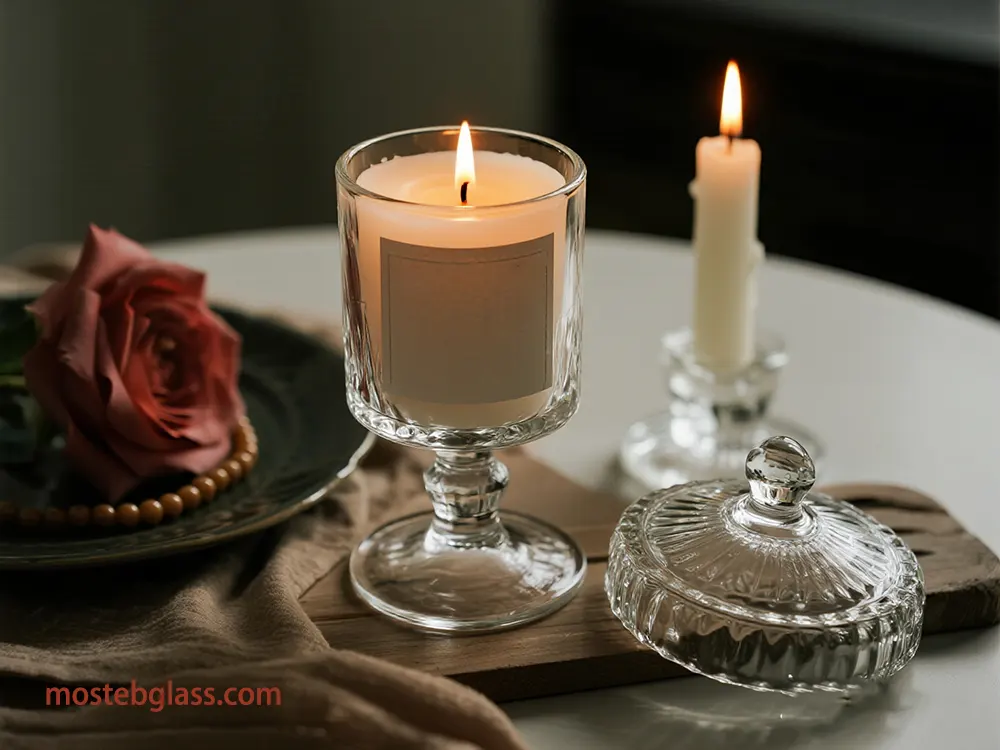
2. Designing for Desire: Aesthetics, Function, and Innovation
This chapter highlights consumer behavior aspects and design psychology that used strategically in Mosteb luxury candle jars by means of the artistic conception, ergonomics, and functional features to take market trends.
2.1. Psychological Triggers and Emotional Engagement through Packaging
At Mosteb, luxury candle packaging not only performs the basic function of product protection but also is an emotionally exclusive experience that makes the brand-customer relationships last. The design communicates stories and emotional power, which make the product be perceived as rare and of high quality, thus, as a result, its value goes up. Consumers who get a positive emotional reaction from the packaging are more likely to repurchase the product, as they subconsciously link the feeling with the product itself.
2.2. Color Psychology in Luxury Candle Design
Colors are great mental triggers. Mosteb chooses colors carefully to not only cause certain feelings but also reflect the brand. So, for instance, green can represent health, red – love, yellow – energy, purple – luxury and royalty, and pink – kindness. The use of the same colors in each of the products is what creates a cohesive brand image.
2.3. The Significance of Shape and Form in Perceived Luxury
One of the most potent factors that influence consumer perception of a candle jar is its shape. Consumers associate round shaped jars with smoothness, stylishness, special, and premium characters, whereas square jars are thought to be modern, simple aesthetically. Apart from noting that, Mosteb also delves into the realm of shapes for sculptures to make their products more distinctive and intriguing. In addition to that, the company is taking into account the influence of features of the past, like for instance, having broad formations for masculine products and subtle curves for feminine ones.
2.4. Tactile Feedback and Perceived Weight as Luxury Indicators
Mosteb directs their attention to the selection of materials and application of finishing techniques that give users a feel of handcrafted and luxury indulgence. Through consumer research, it is revealed that the public perceives heavy packaging as quality packaging, while the act of touching packaging may increase the chances of buying because it gives the consumer the feeling of possessing it.
2.5. Transparency and Finish in Glass Jar Aesthetics
The trendiest candle holders are the transparent ones as they not only make the most of the available light, but they also are the best for showing off the color and the texture of the candle and can easily blend in with any kind of room style.Frosted glass is characterized by simple and elegant qualities, and it provides a warm tone for the decorated room by dimming the light coming from the candle, which finds its place among the latest spa and wellness trends.Colored glass holders are fabulous and cool looking, and besides this they can also be vibrant complementing for the decor.
2.6. Dominant Aesthetic Trends: Minimalism, Artisanal, and Biophilic Design
Mosteb exhibits designs leaning on luxury indus-try trend.
- Minimalist Aesthetics: Clean lines, simple shapes, and neutral palettes emphasize elegance and simplicity, as seen in brands like Glasshouse and Ecoya.
- Artisanal Appeal:Jars made of ceramic depict<br>the handcrafted qualities of the product and have<br>great ability to retain the heat while wood parts<br>invite the old and traditional.
- Beauty in hotels, restaurants, offices, adaptation and wholesale opportunities, increasing demand for on-brand decoration. A growing trend for 2025, integrating nature-inspired elements, natural light, and materials (organic textures, warm neutrals, soft greens) to create calming environments.
2.7. Personalization and Customization as Key Value Drivers
The consumers nowadays demand uniqueness of products. Mosteb allows a wide range of customization options such as personalized fragrances, vessel designs, labels, and engraving of the names or patterns on jars and lids, which effectively promotes deep emotional bonding that makes the candles become memorable tokens. The use of custom silicone molds gives an unlimited creative freedom for unique shapes and textures.
2.8. The Unboxing Experience and Sensory Marketing Beyond the Jar
Mosteb is thinking about the inclusion of high-end fittings and closures, for instance, magnetic clasps or ribbon ties, to transform the moment of unpacking into an unforgettable experience, thus, raising the product’s perceived value. The delighting “click” sound of a cap closing is also among the factors that help build up the perception of luxury and high quality.
3. Strategic Market Ascent: Branding, Positioning, and Reach
This part of the report delves into the different maneuvers, branding improvements, and precise promotional campaigns used by the business to step up the market presence of candle jars as a common household item to recognized products that are in demand in different market segments.
3.1. Positioning Sustainability as a Core Value Proposition
Mosteb weaves the theme of sustainability through the whole fabric of its brand right from the item parts to the marketing tales. This covers the usage of plant-based waxes (e.g., RCX, Golden Wax 464), recyclable glass vessels, vegan-friendly fragrances, and wooden wicks.Branding utilizes nature-inspired names, earthy tones, and low-impact eco-icons. The unpacking experience is also green, using such materials as mushroom packaging or Flexi-Hex.This comprehensive approach guarantees that sustainability is a core demonstrable value.
3.2. Target Market Segmentation and Niche Lifestyles
Mosteb defines “eco-conscious consumers” as its primary target and further delineates the market to comprise “wellness-focused consumers” looking for aromatherapy, “luxury brands with CSR initiatives,” and “millennial buyers” giving first priority to convenience, unique designs, and eco-friendly packaging.Women are major promoters, whereas men are showing a growing preference for minimalist designs. Niche lifestyles such as zero-waste, minimalistic, slow, and clean living are also specific target groups.
3.3. Compelling Marketing Narratives and Digital Channels
Mosteb’s marketing narratives are very much in line with the company’s transparence and authenticity values and thus they do not partake in greenwashing.Consumers are emotionally connected through storytelling by giving them a detailed product journey, setting sustainability goals (e.g., water conservation, worker rights), and telling the company’s sustainability voyage. Social media, as one of the digital platforms, is very important to bring these words to the people through videos, infographics, and interactive posts. One of the brands, for instance, Keap Candles, is doing this by giving a share of their profits to the environmental causes.
3.4. B Corp and Cradle to Cradle Certifications for Trust and Innovation
Mosteb is on a journey to acquire different certifications, including B Corp and Cradle to Cradle (C2C). Obtaining B Corp Certification is a signal for good performance in social and environmental areas, accountability, and transparency, thus enhancing brand reputation, generating trust, and, finally, attracting ethical capital.The C2C standard evaluates the product safety, recyclability, and responsibility in five categories (Material Health, Material Reutilization, Renewable Energy and Carbon Management, Water Stewardship, Social Fairness), thus, encouraging the product design for reuse, recycle, or compost and, in turn, gaining the support of the circular economy.
3.5. Diverse Distribution Channels for Market Penetration
Mosteb makes use of several distribution channels such as:
- Retail stores: They are still the major source of revenue for natural candles, contributing about 50%.
- Online platforms:They generate 40% of revenue mostly through e-commerce-led activities that are efficient and attractive to millennials.
- Direct-to-consumer (DTC): It is very important for the provision of personalized services like scent customization and engraving.
- Specialty boutiques and gift shops: Account for 10% of the turnover, focusing on premium candles.
- Emerging opportunities: Wellness retail spaces (yoga studios, spas) and subscription models.
- B2B partnerships: With eco-friendly brands, interior designers, and wellness influencers are a great way to increase the visibility of a brand.
3.6. Financial Implications of Sustainable Practices
Though the incorporation of sustainable materials and a robust supply chain might lead to an increase in the initial production costs, these decisions are worthwhile as they provide significant benefits in the long run. Mosteb is able to draw customers and employees who are individuals of high moral standards and thus the company experiences higher engagement and loyalty as a result.Increased trust and credibility, in turn, lead to a better financial position as probationary periods of socially responsible funds become stakeholders. Besides, the sustainable initiative also results in operational efficiency, improved brand reputation, and new business opportunities.
3.7. Supply Chain Transparency and Communication
Mosteb emphasizes supply chain transparency and is willing to provide open access to information about procurement, environmental impacts, and ethical standards. This is very important because, generally, 90% of a company’s environmental footprint originates in its supply chain.Transparency is a trust builder, as statistics show that 73% of the global consumers are ready to change their consumption habits for the sake of the environment, and 66% of them are willing to pay more for sustainable brands.It also lowers the chances of problems and ensures that the company is following regulations like EU’s CSRD.Mosteb delivers their complicated sustainability messages in a straightforward, real, and instructive manner thus avoiding greenwashing and providing evidence for their claims.
3.8. Market Growth and Competitive Landscape
The market for high-end candles made in the United States is anticipated to hit a value of USD 315.5 million by 2030 with a compound annual growth rate of 11.5% between 2025 and 2030, a trend driven by the wellness and self-care sectors. The global scented candles market is estimated to grow from USD 3.4 billion in 2024 to USD 6.32 billion by 2035, with a compound annual growth rate of 5.80%. The consumer interest in “luxury candle jars” is highly increased seasonally during the fall and this shows the necessity of marketing and product launch strategies that are in line with each other.Mosteb is in competition with brands like Yankee Candle (refillable jars, soy-coconut blends), Diptyque (hand-poured, vegan wax), and Paddywax (artisan-crafted, eco-friendly materials).
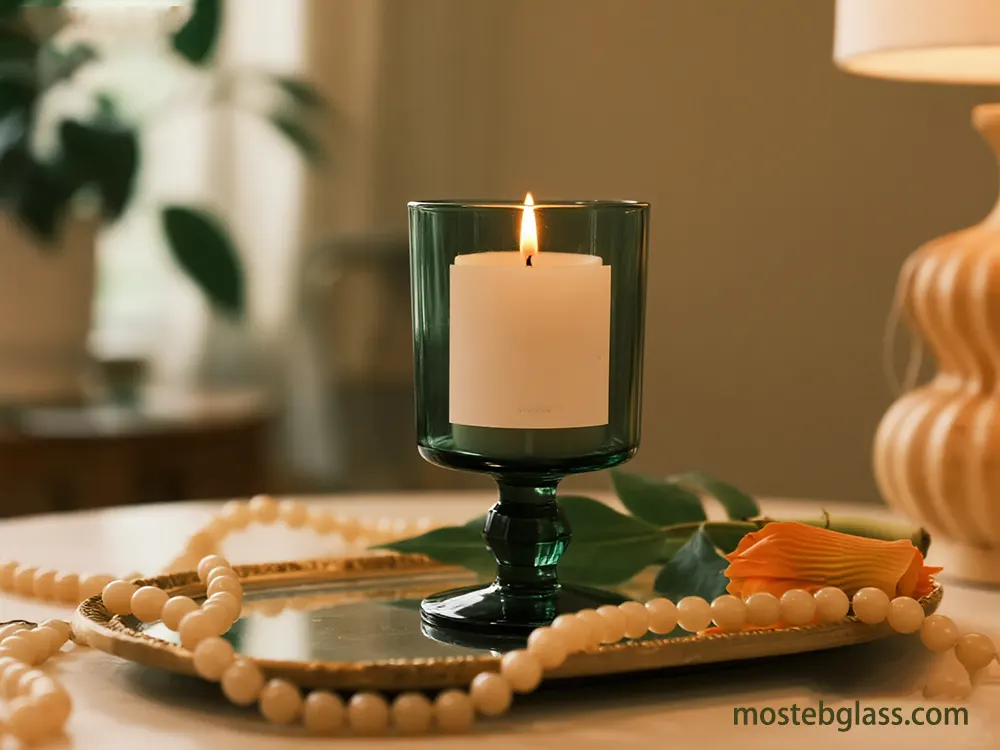
4. Optimizing the Value Chain: Efficiency from Source to Shelf
This part delves into how essential it is for the firm to remain fit by sharpening the supply chain, managing the logistics well, and keeping the operations flexible to satisfy the triple demands of being cost-effective, punctual, and responsive to the ever-changing market requirements.
4.1. Raw Material Sourcing and Cost Drivers (2025 Outlook)
The production of glass Mosteb’s market is going to be very much dependent on factors such as the prices of raw materials and the supply chain optimization in the year 2025 out of which have to be four primary sources of silica sand, soda ash, limestone, and cullet (recycled glass). Prices of silica sand remain stable, while soda ash production is becoming more expensive because of the energy market. At the same time, the availability of cullet varies in different areas, and its consumption is the most energy-saving process with energy consumption and costs. The defining factor in the glass production process is the energy used for the method of melting the glass, which comes especially from natural gas and electricity.
4.2. Production Scheduling and Inventory Optimization
Mosteb plans the inventory in a perfect way, which is mainly achieved by data-driven forecasting, so they can distribute raw materials equitably for production and also inventory levels are kept to a minimum. Demand forecasting is done by AI which uses such models as ARIMA and Prophet to be at par with real-time sales and external factors thus production is adjusted on the spot, so the same does inventory optimization which is also outputted in the dialogue can levels and waste is minimized.
4.3. Optimized Packaging Solutions for Fragile Glass
The best method of packaging the fragile glass candle jars is by using a comprehensive tactic. Among these, it is recommended to wrap each item separately as well as to use materials like bubble wrap, foam, packing peanuts (also, there is eco-friendly cornstarch), shredded cardboard or gel wax for proper cushioning of the product. Dividers in the pack keep the items away from each other and the voids inside the box are filled to avoid the movement of the package. It is advised to use the double-boxing method for a long journey. Apart from this, the proper taping of the lids and also the use of words like “Fragile” and “Handle With Care” will help a lot.
4.4. Efficient Transportation Modes and Carrier Selection
One of the ways of lessening the glass jar damage during the time when the goods are delivered is the parcelization which must include an effort like the use of good-quality pallets and also the use of such things as stretch film and other like corner boards to wrap the load tightly but when you still need to make sure the product is not exposed to the influence of bad weather, then that moment should surface-conditioned. Mosteb selects the dependable carriers, who have a history of good collaboration for transporting fragile goods and also thinks about shipping insurance. In case of large shipments, using the carriers who are skilled in handling the fragile freight and agreeing on volume discounts will help you in lowering the expenses. Glass is something that cannot be stacked or compressed to save the space thus making it less efficient and more costly to ship.
4.5. IoT for Real-time Tracking and Condition Monitoring
Mosteb equips their shipping units with the IoT sensors, which provide real-time data on location (GPS), temperature, humidity, shock, and vibration. Thus, it allows for improved security of the cargo (for instance, by recognizing the unauthorized opening of doors) and more excellent end-to-end visibility, together with the option of reaching out to the problem before it actually occurs.
One of the leading technology companies towards smartcontainers with vast sensor solutions for glass rack tracking and container management is Traxens and Heliot Europe.
4.6. Blockchain for Enhanced Traceability and Transparency
By using blockchain technology, one can have a safe, decentralized digital ledger that keeps track of every transaction and movement within the supply chain and cannot be changed later on. This leads to clear visibility in real-time of the entire supply chain, improved traceability, and even authenticity verification, which are very important to prevent fraud and guarantee the right ethical sourcing of goods. Besides, it also supports the company very much in meeting the evolving regulatory requirements by having the tamper-proof audit trail available at all times.
4.7. Predictive Analytics for Demand Forecasting and Risk Mitigation
Machine-learning-powered predictive analytics, using such models as ARIMA and Prophet, account for the historical data of sales, the market condition, the cyclicality of the year, and other factors like weather to come up with very precise demand forecasts. Such a device is instrumental in the process of the firm by means of having the exact level of the inventory, lessening the waste, and at the same time increasing the overall effectiveness of the workflows and the customers’ satisfaction. It makes it possible that the production schedules and inventories can be managed in a real-time manner by the data-driven decision that arises from the dynamic environment.
4.8. Regionalized Manufacturing Hubs and Local Partnerships
Mosteb has diversified its sourcing by depending on several suppliers and building local partnerships to decrease the lead times and the transport costs thus, it is resulting in the strengthening of the supply chain resilience. The European glass packaging industry, powered by more than 160 production sites, can be cited as the case of a regionalized approach. Major glass bottle manufacturers like O-I Glass, Ardagh Group, and Verallia have their facilities in the different key regions of the world, which indicates that they have a combination of global reach and regional presence in these areas.
4.9. Role of Specialized Third-Party Logistics (3PL) Providers for Fragile Goods
The company Mosteb teams up with best-in-class 3PLs such as Buske Logistics, Fulfyld, Speed Commerce, EASE Logistics, and SHIPHYPE for the handling of fragile goods provision of services. These providers furnish customer-focused solutions that consist of the areas of specialized packing, the use of materials with good shock-absorbing capabilities in storage, careful handling, inventory management through real-time identification, and the creation of optimized shipping networks. By transferring the logistics function to 3PLs, the company can save on operating expenses, obtains the possibilities of extending its operations, being more flexible, getting the newest technology, ensuring the fulfillment of legislative requirements, and acquiring the expertise of risk management.
4.10. Strategies for Managing Geopolitical Risks and Natural Disasters
Mosteb limits possible geopolitical hazards such as trade conflicts or wars as well as natural calamities like earthquakes, floods, or pandemics by spreading out its supplier network over several places, getting info on the political and economic stability of the areas, and basing the research of suppliers on their past performance. Supply chain resilience means the capability of the enterprise to be able to move its production or sourcing as well as having the availability of a flexible strategy of preparedness, response, and recovery. The COVID-19 pandemic has discovered the inherent flaws and dependencies in global supply chains that are not obvious.
5. Pioneering Sustainable Practices: Eco-Conscious Production & Materials
The section reflects on how the factory incorporates environmentally friendly practices such as sustainable sourcing, energy-efficient production, eco-friendly materials, and circular economy models within the factory.
5.1. Significant Environmental Benefits of Recycled Glass
Mosteb gives first priority to the use of recycled glass (cullet) because of its clear-cut environmental benefits. In general, the use of cullet drastically lowers the primary energy demand (PED) and global warming potential (GWP) of the product compared to the use of virgin materials. The GWP advantage is the main reason of the energy saving that results from the consumption of energy and emissions of CO2.
5.2. Quantifiable Energy and CO2 Savings with Cullet
With every 10% increase in the fraction of the cullet the energy used in melting is typically decreased by 2-3% (or 2.5-3.3%) and the CO2 emissions are cut by approximately 5%. In a case like this, one hundred percent cullet may save 25.4% in melting energy as opposed to 100% virgin materials. Besides that, one ton of recycled glass stands for 1.2 tons of the virgin raw material thus the average CO2 saving is 0.67 tonnes in Europe.
5.3. Dominance of Melting in Environmental Impact and Raw Material Conservation
The production phase, especially the melting stage of glass in the furnace, is the one that accounts for the highest percentage of most environmental impact categories in glass container production. Glass recycling is thus significantly lowering the requisites for virgin raw materials like sand, soda ash, and limestone, that together with their respective amounts 1.17 to 1.2 tonnes, are figuring per each one-ton glass recycled. Besides helping to reduce the energy needs, it cuts the CO2 emissions, extends the life of the furnace, and lessens landfill waste.Glass recycling also contributes to reduced water usage.
5.4. Minor Impact of Transportation in Overall LCA
The energy impact of transporting glass packaging, including raw materials and cullet, is a small part of the total energy used in container glass production, typically less than 10% (or 4-5% in some studies). The CO2 savings from glass recycling are generally as large as, or larger than, the transportation emissions, offsetting any perceived environmental burden from shipping.
5.5. Adherence to LCA Methodologies and Software
Mosteb is carrying out Life Cycle Assessments (LCAs) that are in line with international standards, in particular, conforming to the norms set by ISO 14040/44, which, among other things, ensures the transparency, impartiality, and comparability of the data.
Mosteb prefers the use of leading industry LCA software tools such as SimaPro and GaBi (LCA for Experts), because of their extensive industrial datasets and advanced modeling capabilities.Mosteb uses Impact assessment methods like CML 2001 and ReCiPe to quantify different environmental impact categories.Mosteb is using a “cradle-to-cradle” LCA method that incorporates stages such as raw material extraction, production, usage, and end-of-life management, as well as recycling back to its original use.
5.6. Critical Parameters Influencing Environmental Footprint
- Cullet Percentage:One of the most significant factors in minimizing the environmental footprint is the increasing percentage of cullet in the glass batch. Research confirms that the environmental impacts throughout the life cycle decrease as the cullet content increases. For instance, a 65% cullet composition brings the Global Warming Potential (GWP) down by about 6% compared to the one with 44% cullet.
- Furnace Technology and Energy Sources: The glass manufacturing process is very energy-demanding. Mosteb makes major investments in efficient furnace technologies. An electric furnace is more energy-efficient (thermal efficiency may be over 70%, up to 85%) and it emits very little CO2 directly. However, the real environmental benefit of such a furnace depends on the use of renewable electricity. Although gas furnaces are the most common, their thermal efficiency is lower.
- Process Emissions: Nearly 15-25% of the total CO2 emissions are “process emissions” coming from the chemical changes of raw materials like carbonates during melting. In addition to that, the direct use of cullet also helps in curtailing these emissions as it takes the place of the virgin raw materials.
- Glass Weight: On the other hand, material efficiency is equally as important; it might be necessary to use lighter glass bottles for some applications in order to reach the same level of environmental impact.
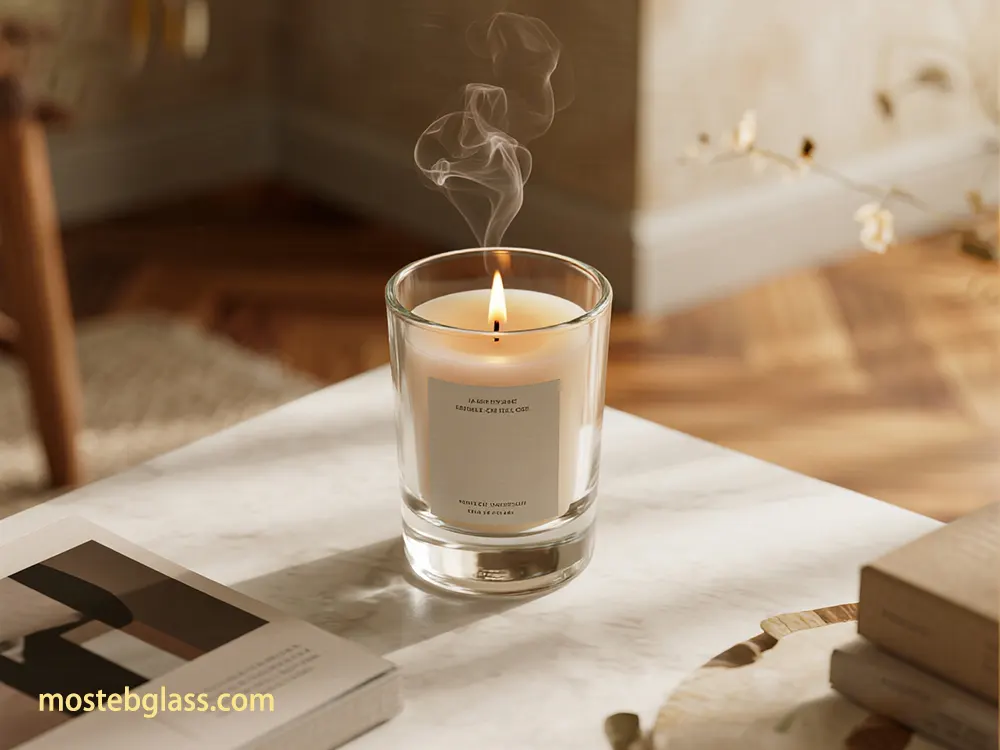
5.7. Challenges and Opportunities in Increasing Cullet Utilization
Mosteb has identified various challenges in the efforts to increase cullet utilization, such as contamination (e.g., labels, metals, ceramics), exorbitant transport costs, irregular supply, and strict quality standards. The list of possibilities includes the implementation of closed-loop systems, setting up recycling facilities at the site for production scraps, buying advanced cullet cleaning and sorting equipment, inventing additives for use with cullet, cooperating with recyclers, and getting support from the government. Efficient collection schemes, better design, standardized systems, and clear consumer information are essential for higher circularity.
5.8. Potential for Closed-Loop Recycling Systems for Candle Jars
Utilization of glass in a closed “bottle-to-bottle” loop is 100% and can be done infinitely without any loss of its fundamental properties, thereby, making glass a pioneer of circular economy principles.
Europe has been successful in establishing a properly functioning system of closed-loop glass packaging recycling with 85% of the collected glass being re-melted into new packaging. The “Close the Glass Loop” project intends to achieve a 90% collection rate by 2030.
While many of the concepts are transferable, candle jars might have certain problems such as wax residue contamination, particular glass compositions, and the requirement for separate collection and sorting streams so that high-quality cullet suitable for new candle jar production can be obtained. Recycling of glass is mostly local; in Europe, cullet transport is usually no more than 50 km, which adds to the environmental advantages.
6. Forecasting Future Success: Trends, Adaptations, and Growth
This part is looking at industry changes next, naturally progressing technological innovations, changes in consumer preferences and strategic moves needed to stay on top of the market and be the first to come up with the next generation of bestsellers.
6.1. Smart Packaging Integration for Enhanced Functionality
Mosteb is planning the future integration of smart packaging technologies in candle jars that would also involve built-in sensors, electronics, and software. Such units can be made to control temperature, humidity, as well as determine the place and even the time of the product’s usage, therefore, sending the data both for quality control and user experience enhancement.
6.2. Interactive Consumer Engagement via Digital Codes and AR
By means of QR, RFID, or NFC labels, a future candle jar will be able to give a smartphone user quick access to the product details, invite them to participate in an interactive marketing activity like seeing an augmented reality experience, or a security feature implementation such as the product being theft-proof or difficult to counterfeit.
6.3. Advanced Material Science for Performance and Sustainability
Mosteb is heavily engaged in research for new materials that would reform the whole concept of packaging. One example of such materials is bioplastics (e.g., PLA derived from corn starch) which provides eco-friendly, fully biodegradable alternatives. While nanomaterials like carbon nanotube-based nanocomposites can improve barrier properties, electrical and thermal conductivities and even antimicrobial characters. There are also self-healing materials and lignin-based composites having antioxidant and UV-blocking attributes, which are among the latest trends.
6.4. AI-Driven Intelligent Packaging for Real-time Monitoring
Fusing Artificial Intelligence (AI) with polymer nanocomposites paves the way for intelligent packaging to become capable of identifying, interacting with, and modifying various environmental situations. The real-time data handling, anomaly recognition (e.g., decay, interference), and foreseeing analytics for the optimal storage time enable the modernization of product security, quality, and shelf life to be effected through this innovation.
6.5. Integrated Smart Features for User Control and Ambiance
Mosteb imagines the “smart candle jars” to have extensibility features like incorporated LED lights or Bluetooth speakers. Even more sophisticated smart scented candles might grant the users a remote control with the help of their smartphones or smart home systems where they could modulate the illumination, fragrance discharge degree, and also schedule smart timing activities. Upcoming versions could be interconnected with other smart home appliances for turning the settings into automatic ones based on, e.g., the amount of light in the room or the music being played.
6.6. Automated Self-Extinguishing Mechanisms for Safety
The safety of the candle has been enhanced through innovations such as the inclusion of self-extinguishing mechanisms. The “Smart Candle Platforms” that are patented in this regard can have components sensitive to the tipping/fall movement (accelerometers/gyroscopes), and, additionally, proximity sensors for identifying if a certain area is free or occupied, and electrically powered fans for “blowing out” flames. The point in time when the auto-extinguishing will take place is also at the core of safety, alongside the Bluetooth-enabled snuffers and mechanical contrivances that have been conceptualized for that purpose.
6.7. Patent Activity and Venture Capital Investment in Packaging Technology
Patent applications emphasize that the main concern is with smart and interactive packaging, which also includes the structural components becoming part of the sensor or communication device, and chip cards with dual communication interfaces.The “Packaging Tech” area is teeming with life as far as venture capital and private equity investments are concerned, and it is no less than robust. The startups that deal with sustainable packaging, in particular, were the recipients of a 31.57% increase in their funding in 2025 (up to September) as compared to 2024, with the likes of TemperPack, Ecovative, and TIPA being the most notable contributors.
6.8. Ethical Considerations for Data Collection in Smart Products
Mosteb is well aware that by adding smart features, significant issues are raised in terms of ethics, specifically when it comes to data collection, privacy, surveillance, and data ownership. The producers have the obligation to guarantee that the data collection is done in a transparent way, that the consent of the users is properly informed and that they are given the opportunity to decide over their data. The danger of data leaks is quite high, and Mosteb, therefore, will be considering other consent models like dynamic consent and data trusts to better cope with the problem of continuous data collection.
6.9. Sustainability and Personalization as Core Design Trends
Mere smart functionalities aside, the upcoming candle jar designs of Mosteb for the years 2024-2025 are primarily focused on two important aspects, namely environmentally friendly use of recycled glass, biodegradable materials, refillable jars and personalization through custom engraving, unique shapes, textured surfaces. A trendy lifestyle of multi-functional jars could also be utilized as drinking glasses or planters while at the same time, satisfying the eco-conscious consumer preferences.
